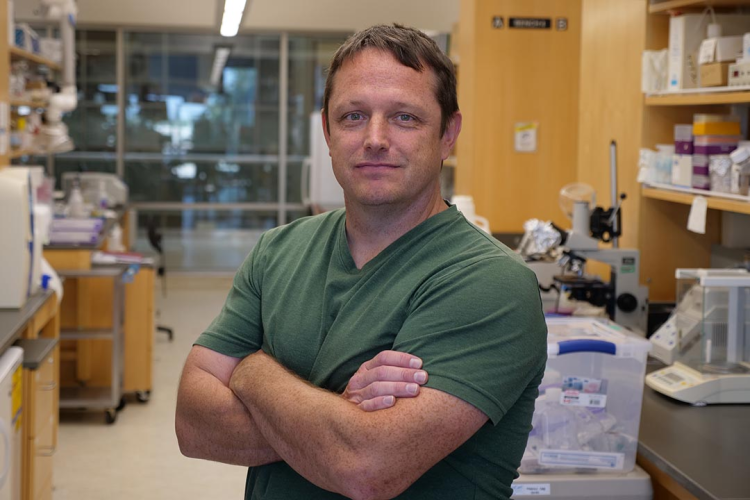A team of University of Saskatchewan (USask) researchers have identified a pathway to help the human body defend itself against sepsis - a life-threatening condition caused by the body's inappropriate response to an infection.
Sepsis is the No.1 cause of death in the intensive care unit of hospitals worldwide and a major concern for health scientists and medical professionals alike.

Dr. Scott Widenmaier (PhD), an associate professor in the Department of Anatomy, Physiology and Pharmacology in USask's College of Medicine. (Photo: Matt Olson)
Dr. Scott Widenmaier (PhD), an associate professor in the Department of Anatomy, Physiology and Pharmacology in USask's College of Medicine, has zeroed in on a specific protein that might be key to helping the body fight back against the potentially life-threatening condition.
By manipulating this protein, researchers believe there is a new avenue to protect patients against sepsis. Widenmaier and his team have had their research recently published in Cellular and Molecular Gastroenterology and Hepatology.
"Sepsis is the largest cause of death in the intensive care unit globally," Widenmaier said. "Sepsis can cause damage to organs like the heart, kidney, and lungs. It can also cause liver dysfunction, and when this occurs, the liver is not able to properly perform its functions that are useful in helping the body deal with an infection."
Sepsis is caused by the body's immune system response to infection causing damage to the body itself. As Widenmaier puts it, many people believe that bacteria or a virus they acquire are what causes people to get sick. However, it's the body's response to the infection that results in severe sickness and can escalate to sepsis - what Widenmaier identified as "a dysregulated immune response that leads to life-threatening complications."
"The immune system releases cytokines and various factors that are trying to kill the bacteria or the virus, but the process of doing it actually dramatically changes our physiology and leads to us being really sick," Widenmaier said.
While conventional methods for treating sepsis have been targeted at mitigating the infections that might lead to sepsis, Widenmaier said more recent studies have recognized that the body itself has built-in disease tolerance mechanism that could be harnessed to protect itself from the potential damage. In other words, when disease tolerance is working well, the process of killing the infection won't cause the person to get nearly as sick and preserve healthy organ function.
Widenmaier and his team identified a "transcription factor" protein in the liver called NRF1, which acts as a "molecular switch" to help control the body's own disease tolerance response. In experimental models infected with E. coli, over-expressing the NRF1 protein led to better overall responses to infection and protection against sepsis.
When over-expressed, the protein enables the liver to secrete more of a special particle called very low-density lipoprotein (VLDL), which better protects organs against damage caused by sepsis. It's this connection between the NRF1 "switch" and the liver's production of VLDL that Widenmaier says may be a promising approach to improve the outcomes of patients with sepsis.
"Our lab is very interested in finding ways to either pharmacologically or genetically manipulate NRF1 to promote health," he said.
Widenmaier credited his team - including colleagues, students and trainees - for their work in identifying this potential target for sepsis treatments and for the resulting research paper.
The next step for this research would be to see how feasible this pathway might be for treatment and whether it is still active in conditions when sepsis is very common - and while they aren't at the stage of human trials yet, Widenmaier said he wants to delve deeply into this new area in the search for better sepsis care.
"We want to explore this quite intensively," he said. "There's a lot of clinical investigators across the country ... I'm interested in continuing those connections and trying to strengthen them, and hopefully we can find a place where clinicians and our lab can benefit from the science."












